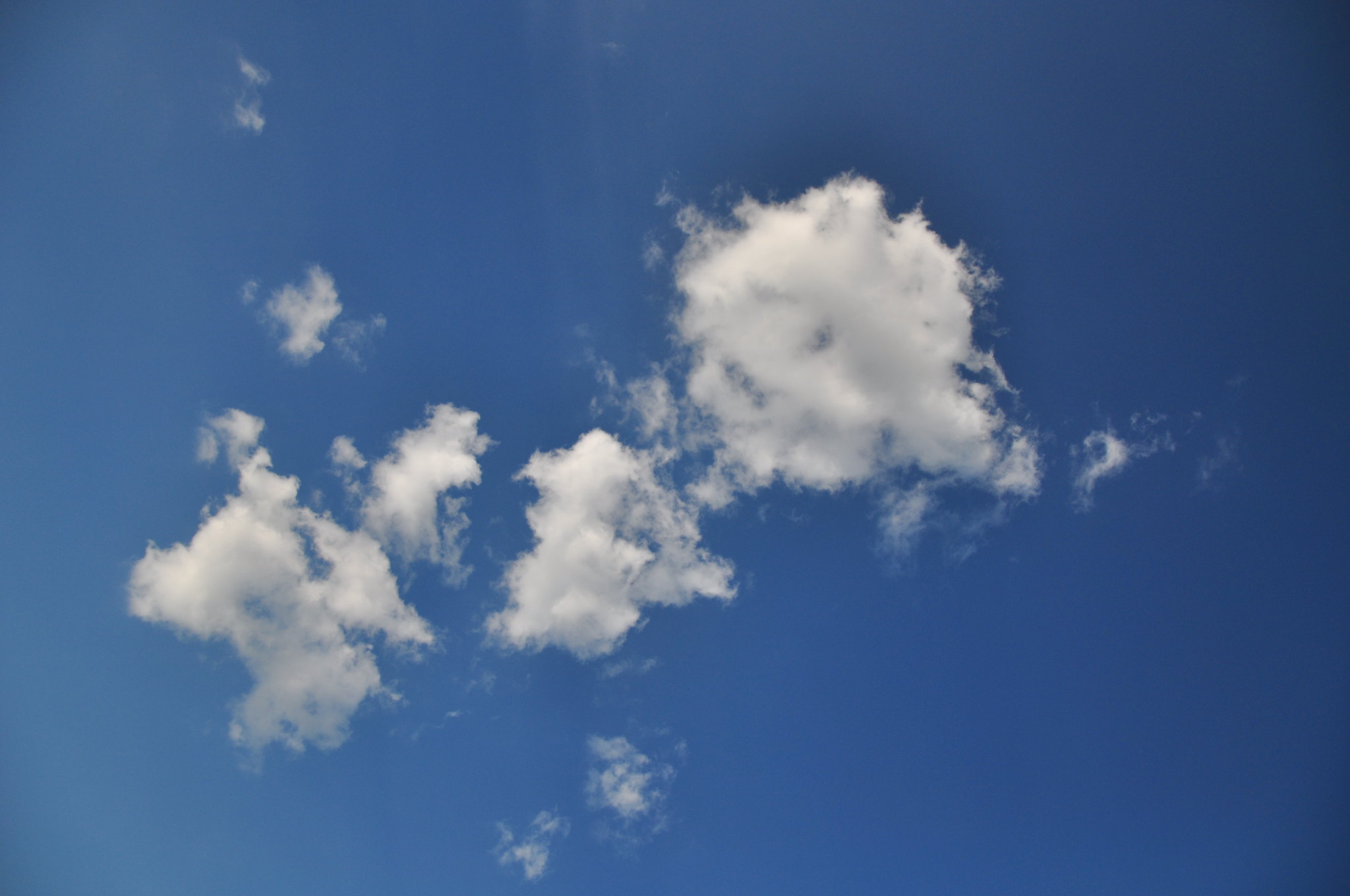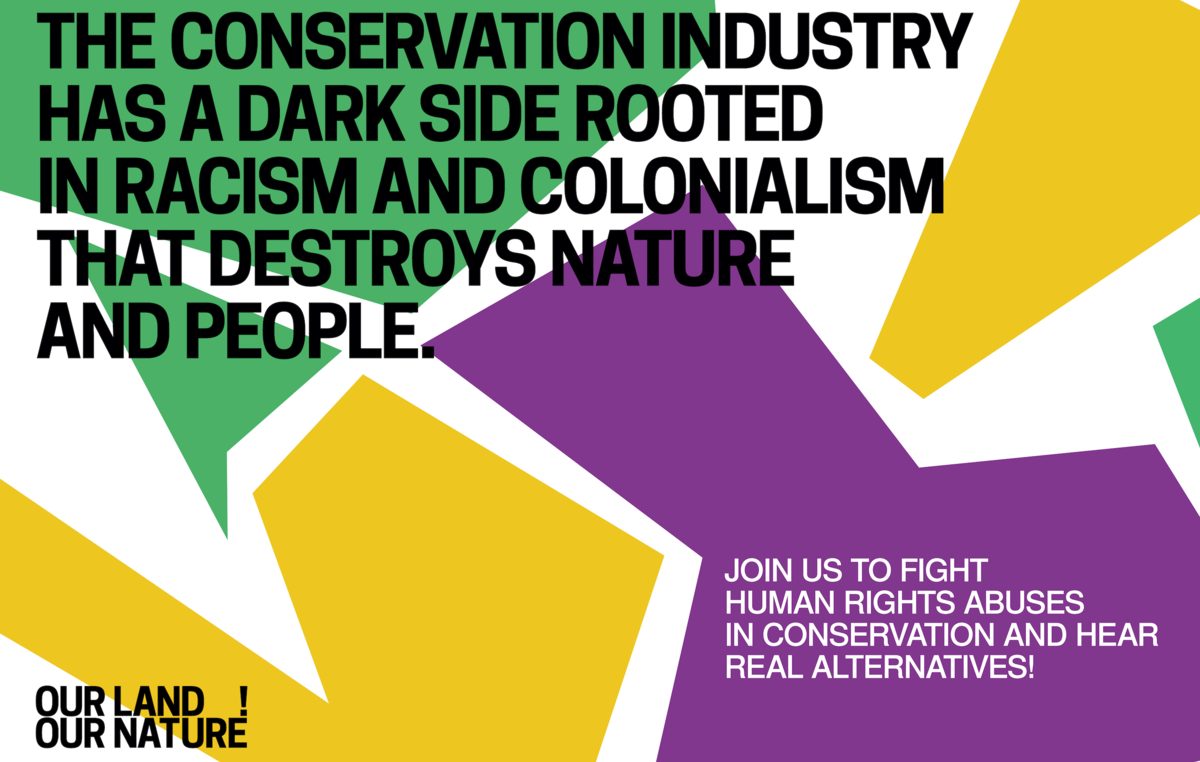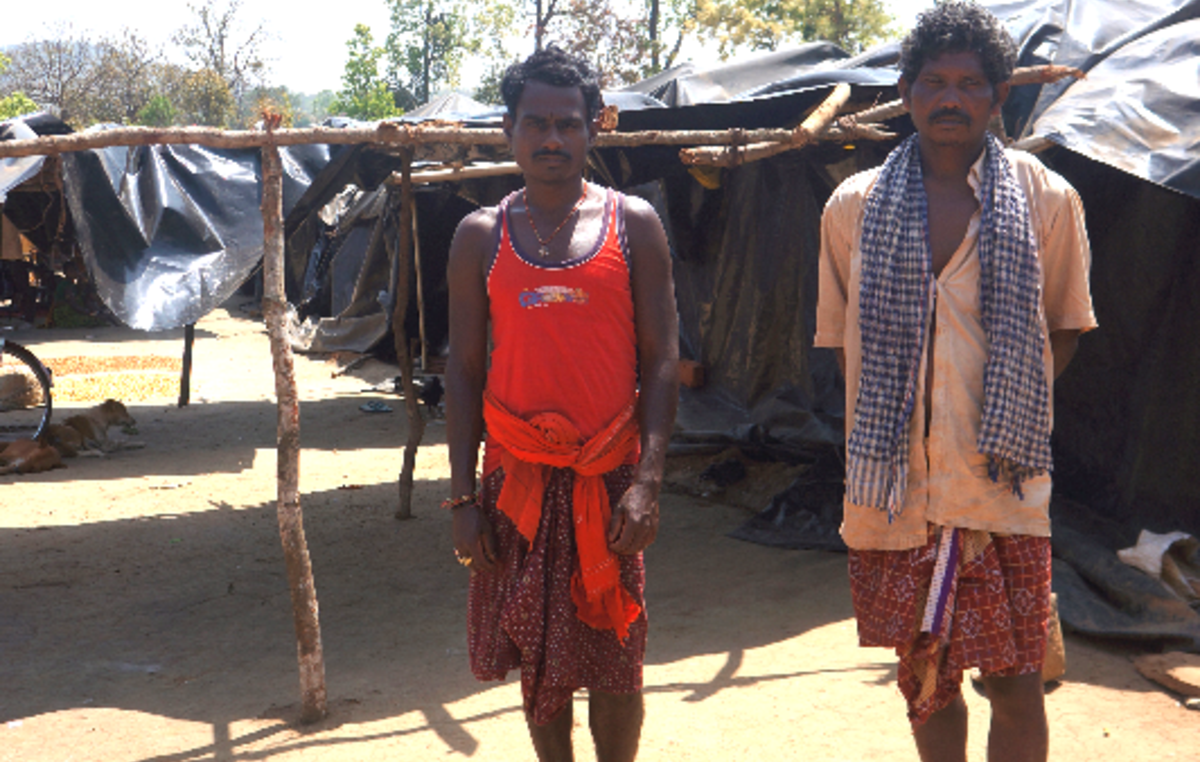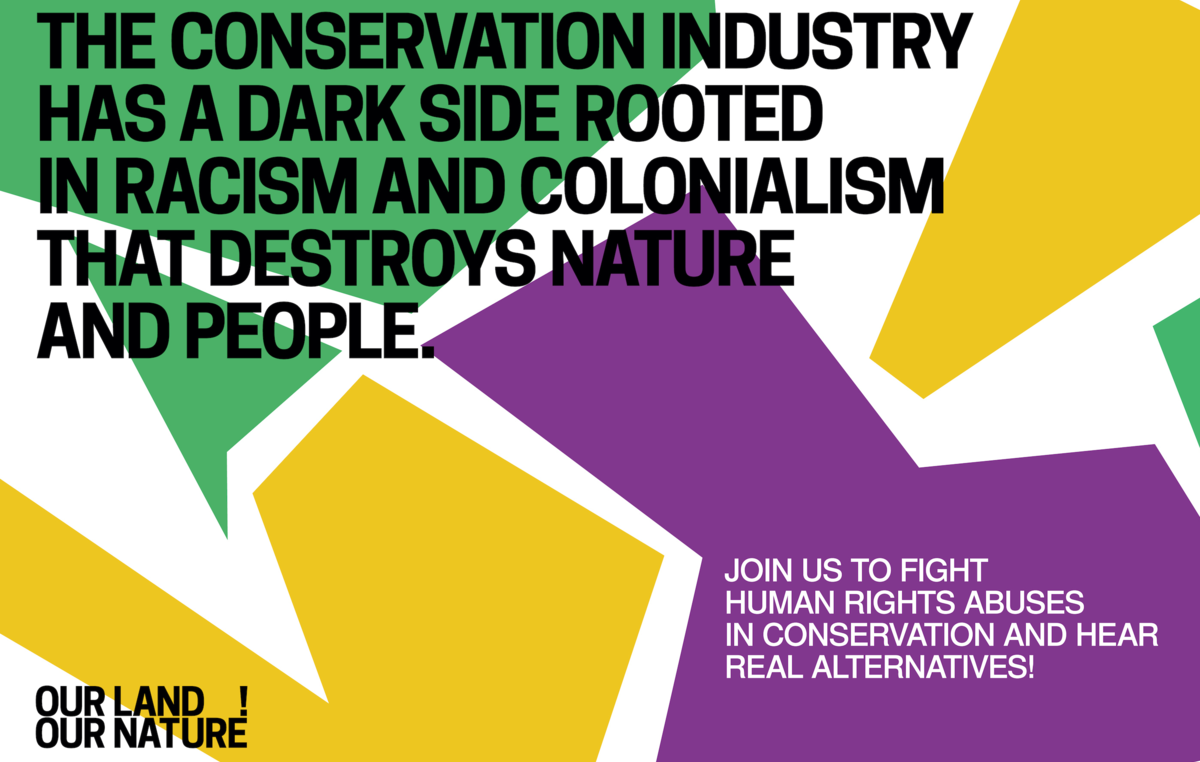
by DGR News Service | Dec 12, 2021 | Alienation & Mental Health, Biodiversity & Habitat Destruction, Climate Change, Mining & Drilling, Music & Art, Protests & Symbolic Acts, The Problem: Civilization, Toxification
This article first appeared on the Association for the Tree of Live Website.
By JEAN ARNOLD
A ravenous, yet decrepit cyborg – part machine, part zombie – lurches onward as it is programmed to do. Its hunger is so insatiable that it eats its own flesh; it eats its offspring; and it eats the future. The catabolic effects are inescapable and its death rattle reverberates for miles. An entire city lives inside this beast. Yet in this late hour, inhabitants put their heads down and carry-on as usual, for they are all dependent upon this monster for their very own food, water, and shelter. No one dares utter a stray word, until the day one brave soul holds up a mirror that reveals who they have become.
A decade ago, I attended a series of contentious activist meetings with Rio Tinto, the mega-mining corporation that owns the massive Kennecott copper pit in the Salt Lake Valley. Rio Tinto planned to expand the mine, and activists were pushing back. The meetings foundered and collapsed upon the lack of viable possibilities for avoiding local impacts and for making operations more sustainable. Activists’ proposals were considered impractical and unprofitable. Ultimately, Kennecott got its expansion and activists got nothing.

Jean Arnold, Civilization, 2012, oil on canvas, 42 x 42 inches.
An early Egyptian pyramid is seen with the gaping hole of the Kennecott copper pit. As civilization builds up monuments to itself, it must tear down into Earth for her treasures.
As a visual artist, I took my angst to the studio and captured eviscerated earth in a series of paintings and drawings, depicting large-scale mining operations that are rarely seen or considered by the public. What better way to reveal our civilization’s insatiable hunger for resources?
I realized that the mining industry cannot be greened, intrinsically by its very nature. Mining casts a long shadow: habitat loss, land theft, worker exploitation, local health impacts, and groundwater contamination, to name just a few issues. Without mining and other forms of extraction, Industrial Civilization could not exist. Yet we rarely ponder our Wonder-World’s material basis and its extraction costs.
Turns out I’m not the only one working in this vein – far from it.
This year a broad panoply of photographers, painters, poets, and printmakers are raising a ruckus in a four-continent constellation of almost sixty exhibits, installations, performances, and events under the rubric “EXTRACTION: Art on the Edge of the Abyss.” When EXTRACTION originator Peter Koch announced the project, it took off like wildfire. Creators are shining lights on all forms of the omnivorous extractive industry, “from mining and drilling to the reckless plundering and exploitation of fresh water, fertile soil, timber, marine life, and innumerable other resources across the globe.” The project’s broad definition begs the questions: In our civilization, what isn’t based on extraction? What isn’t affected by extraction?
The Algonquin word “wetiko” reveals extraction as a symptom of the culture-wide soul-sickness driven by domination, greed, and consumptive excess. It blinds humans from seeing ourselves as part of an interdependent whole, in communion with all of life. It is through this toxic mindset that the world is divided up and consumed for profit.
Extraction is an uncomfortable topic: it confronts us with our system’s voracious appetite for taking Earth’s riches without reciprocity – the very epitome of wetiko. Sure, we can point at capitalism, corporations and elite interests, but as participants in this wetiko culture we are all infected by this mind virus.
Far beyond a “problem” – extraction and its consequences pose a predicament without escape. Humanity is hitting planetary limits: declining resources, excess CO2 in the atmosphere, and plastic choking our oceans. Many of the proposed “solutions,” are just new iterations of the same paradigm, bringing more extraction. For example, see our blog “We are Strip-Mining Life While We Drink ‘Bright Green Lies’” as to why “green” tech will never save us. Humanity has dug itself deep into a hole from which few of us may emerge.
Since stories create meaning, the “wetikonomy” seeks to maintain itself through a tight control over its own narratives. In our situation, the system rewards those that uphold its delusions: endless growth, techno-magic, fulfillment through consumption, and superiority over nature. We are told there is no alternative and things are getting better all the time.

Stephen Braun, The Hoarder, 2009, raku ceramics, 24 x 30 x 8 inches.
Clinging to the same mentality at the root cause of the crises.
The pressure to act according to these grand-yet-contradictory narratives is pervasive, which means compliance is near-universal. Witness the charades played by world leaders and diplomats at decades of climate conferences, giving lip service to fossil fuel phase-out while maintaining the techno-growth-extraction paradigm – essentially mocking the stated climate goals by clinging to the same mentality at the root cause of the crisis. Does anyone think this year’s climate conference, COP26 in Glasgow will play out differently?
Why are people so willing to surrender their agency? Society is captivated by a grand bargain described by social critic Lewis Mumford in his 1964 essay “Authoritarian and Democratic Technics”:
The bargain … takes the form of a magnificent bribe … each member of the community may claim every material advantage … food, housing, swift transportation, instantaneous communication, medical care, entertainment, education. But on one condition: that one must not merely ask for nothing that the system does not provide, but likewise agree to take everything offered … Once one opts for the system no further choice remains.
In other words, the bribe offers everyone a share in the largess, that is, the cornucopia of material goods unleashed by this industrial economy — as long as one does not question the costs to others, to ecosystems, or to the future.
The wetiko-spirit hates to be seen and named, as this begins to dissolve its parasitic power over its host. Dissent against the existing paradigm is ignored, penalized, or co-opted – that is, absorbed into the hegemony. Until it’s not. The time comes when costs become unbearable, limits are reached, and opposition finally boils over.
Thus, the last thing the power structure wants is a cultural spotlight on extraction, which exposes the core of our malady. And certainly not through art, which has a visceral, soul-level power – a power that scientific reports, statistics, and warnings do not have. Art can play a prophetic role: bearing witness to unsettling matters and grabbing attention before we can turn away. It can portray possibilities previously unconsidered, vitally needed at this time.

Jos Sances, Or, the Whale, 2108-2109, scratchboard, 14 x 51 feet
This very large scratchboard drawing was inspired by Moby Dick and the history of whaling in America. The whale’s skin is embedded with a history of capitalism in America—images of human and environmental exploitation and destruction since 1850.
EXTRACTION co-founder Edwin Dobb (now deceased) posed the question of our time: Can we break the spell? A growing chorus on the periphery – Greta Thunberg, poets, painters, performance artists, Extinction Rebellion – is revealing the sociopathic end-game holding us in its grip and unraveling slowly in real time. Learning to see wetiko within ourselves and our culture can begin to break its spell. Can we come to see our own hubris? Contraction is coming whether we like it or not – how can we deal with this if we are spellbound? We have no individual or collective roadmap for the coming post-extraction Reality.
The EXTRACTION project’s exhibits and events are winding down, although organizers hope for continuation in some form. Only a few more venues are scheduled to open, yet its effects will continue rippling outwards. The project has legitimized the extraction art movement and showcased some of today’s most potent work. It has broadened my own definition of extraction-inspired art, which helps me see new possibilities. The project will live on in the evolving work of extraction artists and in others forging authentic responses to our global predicaments. Art is all-too-often wed to money and societal embrace, compromising its own power and obscuring rather than illuminating Reality. Artmaking on the margins is not easy, so supporting this work is necessary.

Chris Boyer, Atlantic Salmon Pens, Welshpool, New Brunswick, Canada (44.885980°, -66.959243°), 2018.
Art that challenges the wetiko-extraction paradigm will become even more relevant, as extraction’s impacts widen. Extraction art is not going away, until extraction itself goes away. While industrial-scale extraction has “only” been with us for four hundred years, art has been with us for thousands of generations, since our early ancestors rendered images inside caves.
Listen to an audio of this blog, narrated by Michael Dowd.
Learn more about the EXTRACTION project.
EXTRACTION megazine (648 pages): download for free or purchase a printed copy for $25 + $7 shipping.
Partly a group catalog of extraction-related artwork, each artist or creator’s individual contribution documents their own personal investigations into the extraction question. The project is by no means limited to the visual arts—in these pages you will also find poetry, critical writings, philosophical treatises, manifestos, musical scores, conversations, historical or found photographs, and much more.
Make a donation to the EXTRACTION project.
![Electric Vehicles: Back to the Future? [Part 1/2]](https://dgrnewsservice.org/wp-content/uploads/sites/18/2021/11/Illustration_001_eddark.jpg)
by DGR News Service | Nov 20, 2021 | Biodiversity & Habitat Destruction, Climate Change, Mining & Drilling, The Problem: Civilization
By Frédéric Moreau
In memory of Stuart Scott
Each year while winter is coming, my compatriots, whom have already been told to turn off the tap when brushing their teeth, receive a letter from their electricity supplier urging them to turn down the heat and turn off unnecessary lights in case of a cold snap in order to prevent an overload of the grid and a possible blackout. At the same time the French government, appropriately taking on the role of advertiser for the national car manufacturers in which it holds shares¹, is promoting electric cars more and more actively. Even though electric vehicles (EV) have existed since the end of the 19th century (the very first EV prototype dates back to 1834).

They also plan to ban the sale of internal combustion engine cars as early as 2035, in accordance with European directives. Electric cars will, of course, have to be recharged, especially if you want to be able to turn on a very energy-consuming heater during cold spells.
The electric car, much-vaunted to be the solution to the limitation of CO2 emissions responsible for climate change, usually feeds debate and controversie focusing mainly on its autonomy. It depends on the on-board batteries and their recharging capacity, as well as the origin of the lithium in the batteries and the origin of their manufacture. But curiosity led me to be interested in all of the other aspects largely forgotten, very likely on purpose. Because the major problem, as we will see, is not so much the nature of the energy as it is the vehicle itself.
The technological changes that this change of energy implies are mainly motivated by a drop in conventional oil production which peaked in 2008 according to the IEA². Not by a recent awareness and sensitization to the protection of the environment that would suddenly make decision-makers righteous, altruistic and selfless. A drop that has so far been compensated for by oil from tar sands and hydraulic fracturing (shale oil). Indeed, the greenhouse effect has been known since 1820³, the role of CO2 in its amplification since 1856⁴ and the emission of this gas into the atmosphere by the combustion of petroleum-based fuels since the beginning of the automobile. As is the case with most of the pollutions of the environment, against which the populations have in fact never stopped fighting⁵, the public’s wishes are not often followed by the public authorities. The invention of the catalytic converter dates from 1898, but we had to wait for almost a century before seeing it adopted and generalized.
There are more than one billion private cars in the world (1.41 billion exactly when we include commercial vehicles and corporate SUV⁶), compared to 400 million in 1980. They are replaced after an average of 15 years. As far as electric cars are concerned, batteries still account for 30% of their cost. Battery lifespan, in terms of alteration of their charging capacity, which must not fall below a certain threshold, is on average 10 years⁷. However, this longevity can be severely compromised by intermittent use of the vehicle, systematic use of fast charging, heating, air conditioning and the driving style of the driver. It is therefore likely that at the end of this period owners might choose to replace the entire vehicle, which is at this stage highly depreciated, rather than just the batteries at the end of their life. This could cut the current replacement cycle by a third, much to the delight of manufacturers.
Of course, they are already promising much cheaper batteries with a life expectancy of 20 years or even more, fitted to vehicles designed to travel a million kilometers (actually just like some old models of thermal cars). In other words, the end of obsolescence, whether planned or not. But should we really take the word of these manufacturers, who are often the same ones who did not hesitate to falsify the real emissions of their vehicles as revealed by the dieselgate scandal⁸? One has the right to be seriously skeptical. In any case, the emergence of India and China (28 million new cars sold in 2016 in the Middle Kingdom) is contributing to a steady increase in the number of cars on the road. In Beijing alone, there were 1,500 new registrations per day in 2009. And now with the introduction of quotas the wait for a car registration can be up to eight years.
For the moment, while billions of potential drivers are still waiting impatiently, it is a question of building more than one billion private cars every fifteen years, each weighing between 800 kilos and 2.5 tons. The European average being around 1.4 tons or 2 tons in the United States. This means that at the beginning of the supply chain, about 15 tons of raw materials are needed for each car⁹. Though it is certainly much more if we include the ores needed to extract rare earths. In 2050, at the current rate of increase, we should see more than twice as many cars. These would then be replaced perhaps every ten years, compared with fifteen today. The raw materials must first be extracted before being transformed. Excavators, dumpers (mining trucks weighing more than 600 tons when loaded for the CAT 797F) and other construction equipment, which also had to be built first, run on diesel or even heavy oil (bunker) fuel. Then the ores have to be crushed and purified, using at least 200 m³ of water per ton in the case of rare earths¹⁰. An electric car contains between 9 and 11 kilos of rare earths, depending on the metal and its processing. Between 8 and 1,200 tons of raw ore must be extracted and refined to finally obtain a single kilo¹¹. The various ores, spread around the world by the vagaries of geology, must also be transported to other processing sites. First by trucks running on diesel, then by bulk carriers (cargo ships) running on bunker fuel, step up from coal, which 100% of commercial maritime transport uses, then also include heavy port infrastructures.
A car is an assembly of tens of thousands of parts, including a body and many other metal parts. It is therefore not possible, after the necessary mining, to bypass the steel industry. Steel production requires twice as much coal because part of it is first transformed into coke in furnaces heated from 1,000°C to 1,250°C for 12 to 36 hours, for the ton of iron ore required. The coke is then mixed with a flux (chalk) in blast furnaces heated from 1800 to 2000°C¹². Since car makers use sophisticated alloys it is often not possible to recover the initial qualities and properties after remelting. Nor to separate the constituent elements, except sometimes at the cost of an energy expenditure so prohibitive as to make the operation totally unjustified. For this reason the alloyed steels (a good dozen different alloys) that make up a car are most often recycled into concrete reinforcing bars¹³, rather than into new bodies as we would like to believe, in a virtuous recycling, that would also be energy expenditure free.
To use an analogy, it is not possible to “de-cook” a cake to recover the ingredients (eggs, flour, sugar, butter, milk, etc.) in their original state. Around 1950, “the energy consumption of motorized mobility consumed […] more than half of the world’s oil production and a quarter of that of coal¹⁴”. As for aluminum, if it is much more expensive than steel, it is mainly because it is also much more energy-intensive. The manufacturing process from bauxite, in addition to being infinitely more polluting, requires three times more energy than steel¹⁵. It is therefore a major emitter of CO2. Glass is also energy-intensive, melting at between 1,400°C and 1,600°C and a car contains about 40 kg of it¹⁶.
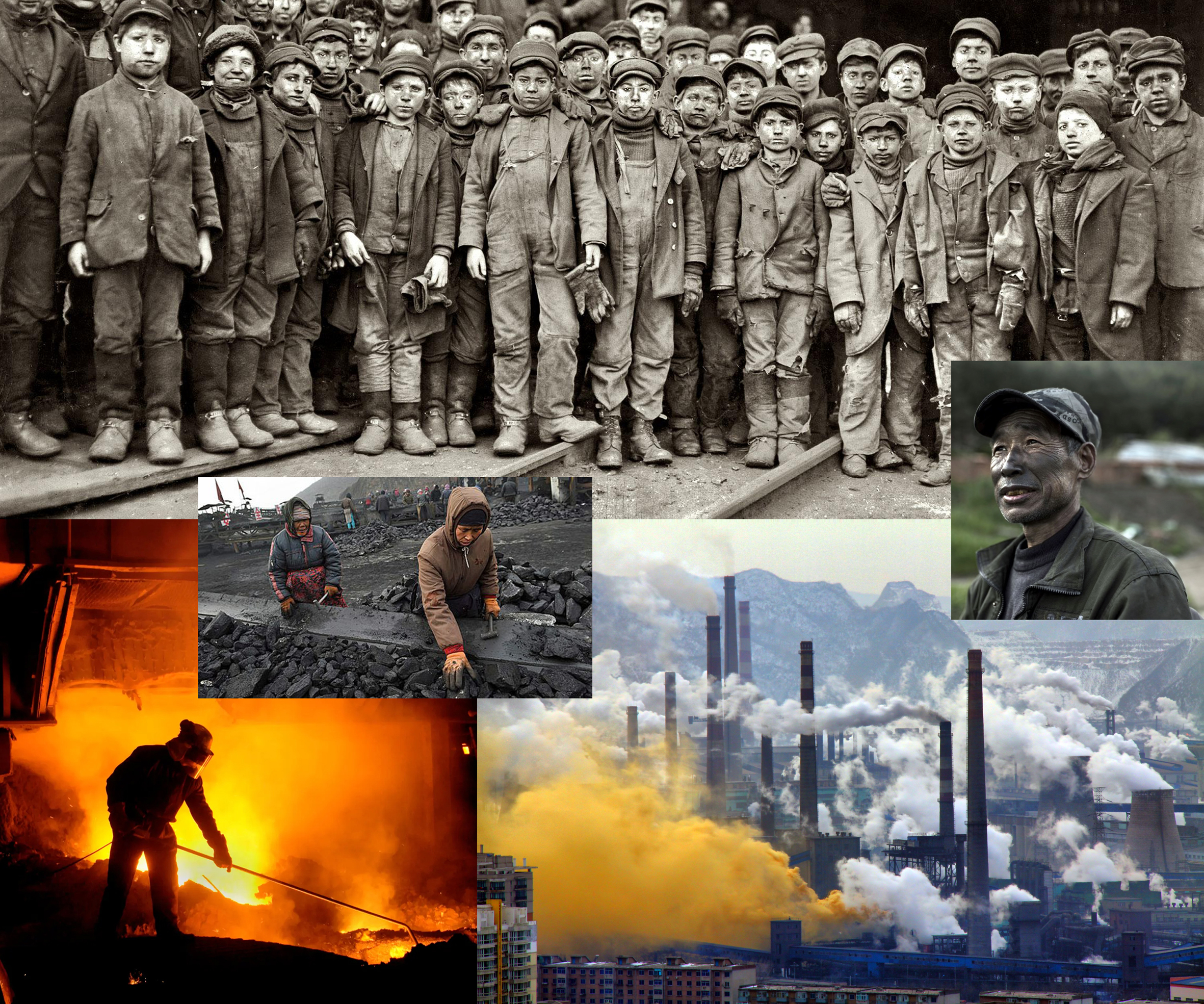
Top: Coal mine children workers, Pennsylvania, USA, 1911. Photo: Lewis WICKES HINE, CORBIS
Middle left to right: Datong coal mine, China, 2015. Photo: Greg BAKER, AFP. Graphite miner, China.
Bottom: Benxi steelmaking factory, China.
A car also uses metals for paints (pigments) and varnishes. Which again means mining upstream and chemical industry downstream. Plastics and composites, for which 375 liters of oil are required to manufacture the 250kg incorporated on average in each car, are difficult if not impossible to recycle. Just like wind turbine blades, another production of petrochemicals, which are sometimes simply buried in some countries when they are dismantled¹⁷. Some plastics can only be recycled once, such as PET bottles turned into lawn chairs or sweaters, which are then turned into… nothing¹⁸. Oil is also used for tires. Each of which, including the spare, requires 27 liters for a typical city car, over 100 liters for a truck tire.
Copper is needed for wiring and windings, as an electric car consumes four times as much copper as a combustion engine car. Copper extraction is not only polluting, especially since it is often combined with other toxic metals such as cadmium, lead, arsenic and so on, it is also particularly destructive. It is in terms of mountain top removal mining, for instance, as well as being extremely demanding in terms of water. Chile’s Chuquicamata open-pit mine provided 27.5% of the world’s copper production and consumed 516 million m³ of water for this purpose in 2018¹⁹. Water that had to be pumped, and above all transported, in situ in an incessant traffic of tanker trucks, while the aquifer beneath the Atacama desert is being depleted. The local populations are often deprived of water, which is monopolized by the mining industry (or, in some places, by Coca-Cola). They discharge it, contaminated by the chemicals used during refining operations, to poisoned tailings or to evaporate in settling ponds²⁰. The inhumane conditions of extraction and refining, as in the case of graphite in China²¹, where depletion now causes it to be imported from Mozambique, or of cobalt and coltan in Congo, have been regularly denounced by organizations such as UNICEF and Amnesty International²².

Dumper and Chuquicamata open-pit copper mine, Chile – Photo: Cristóbal Olivares/Bloomberg
And, of course, lithium is used for the batteries of electric cars, up to 70% of which is concentrated in the Andean highlands (Bolivia, Chile and Argentina), and in Australia and China. The latter produces 90% of the rare earths, thus causing a strategic dependence which limits the possibility of claims concerning human rights. China is now eyeing up the rare earths in Afghanistan, a country not particularly renowned for its rainfall, which favors refining them without impacting the population. China probably doesn’t mind negotiating with the Taliban, who are taking over after the departure of American troops. The issue of battery recycling has already been addressed many times. Not only is it still much cheaper to manufacture new ones, with the price of lithium currently representing less than 1% of the final price of the battery²³, but recycling them can be a new source of pollution, as well as being a major energy consumer²⁴.
This is a broad outline of what is behind the construction of cars. Each of which generates 12-20 tons of CO2 according to various studies, regardless of the energy — oil, electricity, cow dung or even plain water — with which they are supposed to be built. They are dependent on huge mining and oil extraction industries, including oil sands and fracking as well as the steel and chemical industries, countless related secondary industries (i.e. equipment manufacturers) and many unlisted externalities (insurers, bankers, etc.). This requires a continuous international flow of materials via land and sea transport, even air freight for certain semi-finished products, plus all the infrastructures and equipment that this implies and their production. All this is closely interwoven and interdependent, so that they finally take the final form that we know in the factories of car manufacturers, some of whom do not hesitate to relocate this final phase in order to increase their profit margin. It should be remembered here that all these industries are above all “profit-making companies”. We can see this legal and administrative defining of their raison d’être and their motivation. We too often forget that even if they sometimes express ideas that seem to meet the environmental concerns of a part of the general public, the environment is a “promising niche”, into which many startups are also rushing. They only do so if they are in one way or another furthering their economic interests.
Once they leave the factories all these cars, which are supposed to be “clean” electric models, must have roads to drive on. There is no shortage of them in France, a country with one of the densest road networks in the world, with more than one million kilometers of roads covering 1.2% of the country²⁵. This makes it possible to understand why this fragmentation of the territory, a natural habitat for animal species other than our own, is a major contributor to the dramatic drop in biodiversity, which is so much to be deplored.
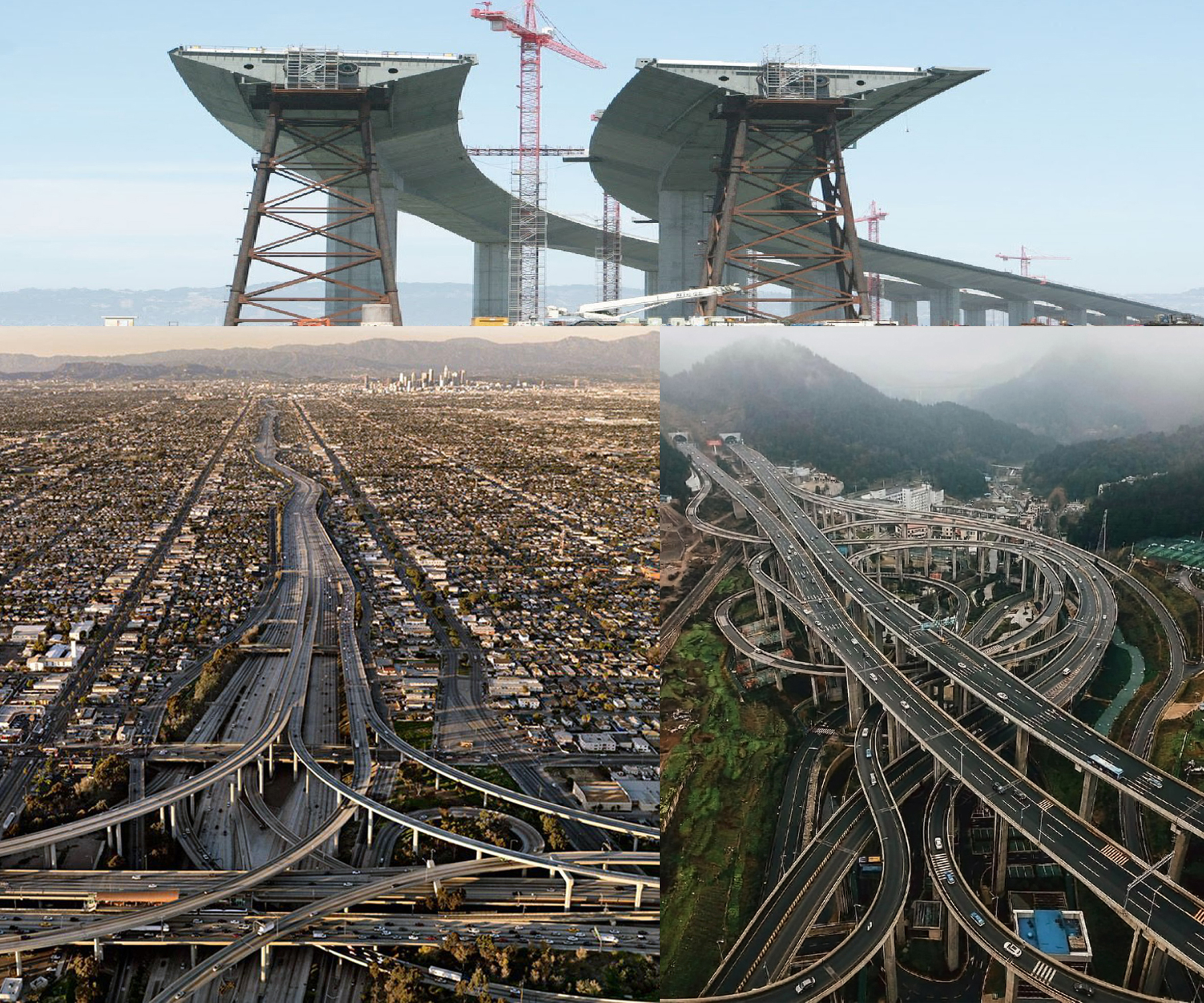
Top: Construction of a several lanes highway bridge.
Bottom left: Los Angeles, USA. Bottom right: Huangjuewan interchange, China.
At the global level, there are 36 million kilometers of roads and nearly 700,000 additional kilometers built every year ²⁶. Roads on which 100 million tons of bitumen (a petroleum product) are spread²⁷, as well as part of the 4.1 billion tons of cement produced annually²⁸. This contributes up to 8% of the carbon dioxide emitted, at a rate of one ton of this gas per ton of cement produced in the world on average²⁹, even if some people in France pride themselves on making “clean” cement³⁰, which is mixed with sand in order to make concrete. Michèle Constantini, from the magazine Le Point, reminds us in an article dated September 16, 2019, that 40-50 billion tons of marine and river sand (i.e. a cube of about 3 km on a side for an average density of 1.6 tons/m3) are extracted each year³¹.

This material is becoming increasingly scarce, as land-based sand eroded by winds is unsuitable for this purpose. A far from negligible part of these billions of tons of concrete, a destructive material if ever there was one³², is used not only for the construction of roads and freeways, but also for all other related infrastructures: bridges, tunnels, interchanges, freeway service areas, parking lots, garages, technical control centers, service stations and car washes, and all those more or less directly linked to motorized mobility. In France, this means that the surface area covered by the road network as a whole soars to 3%, or 16,500 km². The current pace of development, all uses combined, is equivalent to the surface area of one and a half departments per decade. While metropolitan France is already artificialized at between 5.6% and 9.3% depending on the methodologies used (the European CORINE Land Cover (CLC), or the French Teruti-Lucas 2014)³³, i.e. between 30,800 km² and 51,150 km², respectively, the latter figure which can be represented on this map of France by a square with a side of 226 km. Producing a sterilized soil surface making it very difficult to return it later to other uses. Land from which the wild fauna is of course irremediably driven out and the flora destroyed.

In terms of micro-particle pollution, the electric car also does much less well than the internal combustion engine car because, as we have seen, it is much heavier. This puts even more strain on the brake pads and increases tire wear. Here again, the supporters of the electric car will invoke the undeniable efficiency of its engine brake. Whereas city driving, the preferred domain of the electric car in view of its limited autonomy which makes it shun the main roads for long distances, hardly favors the necessary anticipation of its use. An engine brake could be widely used for thermal vehicles, especially diesel, but this is obviously not the case except for some rare drivers.
A recent study published in March 2020 by Emissions Analytics³⁴ shows that micro-particle pollution is up to a thousand times worse than the one caused by exhaust gases, which is now much better controlled. This wear and tear, combined with the wear and tear of the road surface itself, generates 850,000 tons of micro-particles, many of which end up in the oceans³⁵. This quantity will rise to 1.3 million tons by 2030 if traffic continues to increase³⁶. The false good idea of the hybrid car, which is supposed to ensure the transition from thermal to electric power by combining the two engines, is making vehicles even heavier. A weight reaching two tons or more in Europe, and the craze for SUVs will further aggravate the problem.
When we talk about motorized mobility, we need to talk about the energy that makes it possible, on which everyone focuses almost exclusively. A comparison between the two sources of energy, fossil fuels and electricity, is necessary. French electricity production was 537 TWh in 2018³⁷. And it can be compared to the amount that would be needed to run all the vehicles on the road in 2050. By then, the last combustion engine car sold at the end of 2034 will have exhaled its last CO2-laden breath. Once we convert the amount of road fuels consumed annually, a little over 50 billion liters in 2018, into their electrical energy equivalent (each liter of fuel is able to produce 10 kWh), we realize that road fuels have about the same energy potential as that provided by our current electrical production. It is higher than national consumption, with the 12% surplus being exported to neighboring countries. This means a priori that it would be necessary to double this production (in reality to increase it “only” by 50%) to substitute electricity for oil in the entire road fleet… while claiming to reduce by 50% the electricity provided by nuclear power plants³⁸.
Obviously, proponents of the electric car, at this stage still supposed to be clean if they have not paid attention while reading the above, will be indignant by recalling, with good reason, that its theoretical efficiency, i.e. the part of consumed energy actually transformed into mechanical energy driving the wheels, is much higher than that of a car with a combustion engine: 70% (once we have subtracted, from the 90% generally claimed, the losses, far from negligible, caused by charging the batteries and upstream all along the network between the power station that produces the electricity and the recharging station) against 40%. But this is forgetting a little too quickly that the energy required that the mass of a car loaded with batteries, which weigh 300-800 kg depending on the model, is at equal performance and comfort, a good third higher than that of a thermal car.
Let’s go back to our calculator with the firm intention of not violating with impunity the laws of physics which state that the more massive an object is and the faster we want it to move, the more energy we will have to provide to reach this objective. Let’s apply the kinetic energy formula³⁹ to compare a 1200 kg vehicle with a combustion engine and a 1600 kg electric vehicle, both moving at 80km/h. Once the respective efficiencies of the two engines are applied to the results previously obtained by this formula, we see that the final gain in terms of initial energy would be only about 24%, since some of it is dissipated to move the extra weight. Since cars have become increasingly overweight over the decades⁴⁰ (+47% in 40 years for European cars), we can also apply this calculation by comparing the kinetic energy of a Citroën 2CV weighing 480 kg travelling at 80km/h with a Renault ZOE electric car weighing 1,500 kg travelling on the freeway at 130km/h.
The judgment is without appeal since in terms of raw energy, and before any other consideration (such as the respective efficiency of the two engines, inertia, aerodynamics, friction reduction, etc.) and polemics that would aim at drowning the fish to cling to one’s conviction even if it violates the physical laws (in other words, a cognitive dissonance), the kinetic energy of the ZOE is eight times higher than the 2CV! This tends first of all to confirm that the Deuche (nickname for 2CV standing for deux-chevaux, two fiscal horse-power), as much for its construction, its maintenance, its longevity as for its consumption, was probably, as some people claim, the most “ecological” car in history⁴¹.

But above all more ecological as far as energy saving is concerned, all the while failing to promote walking, cycling, public transport, and above all, sobriety in one’s travels. And losing this deplorable habit of sometimes driving up to several hundred kilometers just to go for a stroll or to kill time, therefore promoting antigrowth (an abominable obscenity for our politicians, and most of the classical economists they listen to so religiously). So it would be necessary to go back to making the lightest possible models and to limit their maximum speed. Because even if the formula for calculating kinetic energy is a crude physical constant, that obviously cannot be used as it is to calculate the real consumption of a vehicle. For the initial energy needed to reach the desired velocity, it nevertheless serves as a reliable marker to establish a comparison. To confirm to those for whom it did not seem so obvious until now that the heavier you are, the faster you go the more energy you consume, whatever the nature of that energy is. The pilots of the Rafale, the French fighter aircraft which consumes up to 8,000 liters of kerosene per hour at full power, know this very well.

Having made this brief comparison, we must now look a little more closely at the source of the electricity, because it is an energy perceived as clean. Almost dematerialized, because it simply comes out of the wall (the initial magic of “the electric fairy” has been somewhat eroded over time). Its generation is not necessarily so clean, far from it. In my country, which can thus boast of limiting its carbon footprint, 71% of electricity is generated by nuclear power plants. When it comes to the worldwide average, 64-70% of electricity is generated by fossil fuels – 38 -42% by coal-fired power plants⁴² (nearly half of which are in China that turns a new one on each week). Apart from Donald Trump, few people would dare to assert, with the aplomb that he is known for, that coal is clean. 22-25% is generated by gas-fired power plants and 3-5% by oil-fired plants. Moreover, electricity generation is responsible for 41% (14.94 GT) of CO2 emissions⁴³ from fossil fuel burning, ahead of transport. And our leaders are often inclined to forget that when it comes to air pollution and greenhouse gases, what goes out the door, or the curtain of the voting booth, has the unfortunate tendency to systematically come back in through the window. We can therefore conclude that the French who drive electric cars are in fact driving a “nuke car” for two-thirds of their consumption. And across the world, drivers of electric cars are actually driving two-thirds of their cars on fossil fuels, while often unaware of this.
[Part II will be published tomorrow]
1 The French Government is the primary shareholder for Renault, with 15%, and a major one for PSA (Citroën and other car makers), with 6.2%.
2 https://en.wikipedia.org/wiki/Peak_oil
3 First described by the French physicist Joseph Fourier.
4 https://www.climate.gov/news-features/features/happy-200th-birthday-eunice-foote-hidden-climate-science-pioneer
5 Jean-Baptiste Fressoz, L’Apocalypse joyeuse. Une histoire du risque technologique, Seuil, 2012 & François Jarrige et Thomas Le Roux, La contamination du monde Seuil, 2017 (The Contamination of the Earth: A History of Pollutions in the Industrial Age, The MIT Press).
6 https://hedgescompany.com/blog/2021/06/how-many-cars-are-there-in-the-world/
7 https://www.transportenvironment.org/sites/te/files/publications/2021_05_05_Electric_vehicle_price_parity_and_adoption_in_Europe_Final.pdf
8 https://corporateeurope.org/en/dieselgate-its-tremors-and-role-car-industry-lobbying
9 https://notre-environnement.gouv.fr/IMG/pdf/focus_ressources_naturelles_version_complete.pdf (page 167)
10 Guillaume Pitron, La guerre des métaux rares. La face cachée de la transition énergétique et numérique, Les liens qui libèrent, 2018, p. 44.
11 Ibid.
12 Laurent Castaignède, Airvore ou la face obscure des transports, Écosociétés, 2018, p. 39.
13 Philippe Bihouix et Benoît de Guillebon, Quel futur pour les métaux ? Raréfaction des métaux : un nouveau défi pour la société, EDP Sciences, 2010, p. 47.
14 Laurent Castaignède, op. cit., p. 75.
15 Ibid., p. 194.
16 https://www.statista.com/statistics/882616/us-canadian-built-light-vehicles-average-glass-weight/
17 https://www.latimes.com/business/story/2020-02-06/wind-turbine-blades
18 But here we have to salute as it deserves the courageous political decision to have banned cotton buds and stirring sticks.
19 https://www.fineprint.global/wp-content/uploads/2020/01/fineprint_brief_no_9.pdf & https://www.equaltimes.org/the-pressure-on-water-an?lang=fr#.YPzxq_k6_IU
20 https://chinawaterrisk.org/wp-content/uploads/2016/08/China-Water-Risk-Report-Rare-Earths-Shades-Of-Grey-2016-Eng.pdf
21 https://www.washingtonpost.com/graphics/business/batteries/graphite-mining-pollution-in-china/
22 https://www.amnesty.org/en/documents/afr62/3183/2016/en/
23 https://web.archive.org/web/20211221082924/https://www.ademe.fr/sites/default/files/assets/documents/90511_acv-comparative-ve-vt-rapport.pdf (page 238)
24 https://www.nature.com/articles/s41586-019-1682-5 & https://www.sciencedirect.com/science/article/abs/pii/S0304389420303605
25 https://www.statistiques.developpement-durable.gouv.fr/sites/default/files/2018-10/de114.pdf
26 www.planetoscope.com-mobilité-1838-construction-de-routes-dans-le-monde.html
27 En 2013. https://web.archive.org/web/20230120162448/https://www.routesdefrance.com/wp-content/uploads/USIRF_BITUME_Sept2013.pdf
28 https://www.iea.org/reports/cement
29 https://psci.princeton.edu/tips/2020/11/3/cement-and-concrete-the-environmental-impact
30 https://www.lemoniteur.fr/article/quelle-realite-se-cache-derriere-les-betons-dits-bas-carbone.2123604 & https://elioth.com/le-vrai-du-faux-beton-bas-carbone/
31 https://www.seetao.com/details/70499.html
32 https://www.theguardian.com/cities/2019/feb/25/concrete-the-most-destructive-material-on-earth
33 Summary of the joined scientific assessment, INRA – IFFSTAR, December 2017.
34 https://www.emissionsanalytics.com
35 https://www.nature.com/articles/s41467-020-17201-9
36 http://www.oecd.org/newsroom/measures-needed-to-curb-particulate-matter-emitted-by-wear-of-car-parts-and-road-surfaces.htm
37 https://www.rte-france.com/actualites/bilan-electrique-francais-2019-une-consommation-en-baisse-depuis-10-ans-une-production
38 The Energy Transition Law, voted in 2015, has programmed this reduction by 2035.
39 Ek = ½.m.v², Ek is the energy in joules (1 watt = 3600 joules), m the mass in pounds, and v the velocity in feet per second.
40 https://thecorrespondent.com/310/your-car-has-a-weight-problem-and-we-need-to-regulate-it/41009665950-d1c675d3 & https://www.transportenvironment.org/sites/te/files/publications/2018_04_CO2_emissions_cars_The_facts_report_final_0_0.pdf (page 32)
41 https://car-use.org/la-2cv-citroen-de-loutil-utile-au-loisir-ecologique/
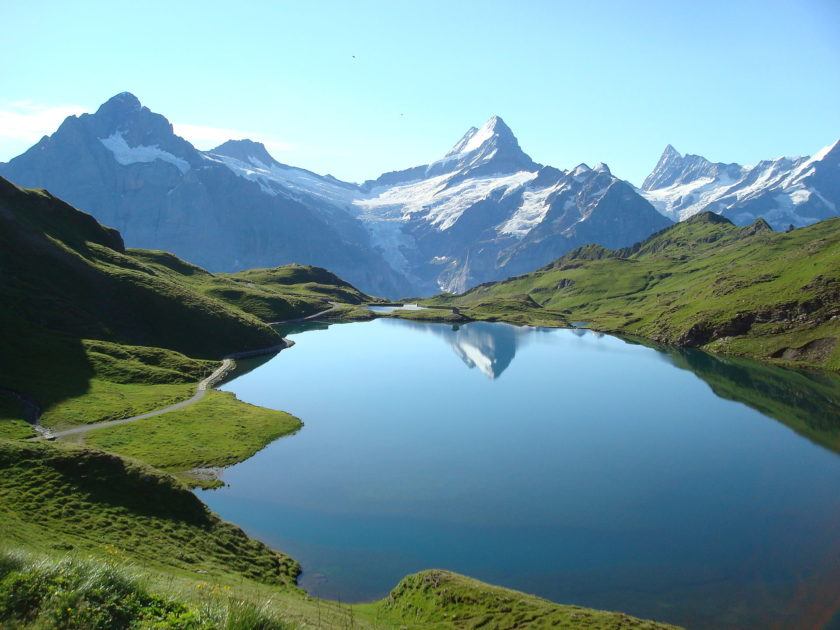
by DGR News Service | Nov 14, 2021 | ANALYSIS, Human Supremacy, The Problem: Civilization
This article originally appeared in Counterpunch.
Editor’s note: What is the Endgame of capitalism? First destroy the planet for profit then profit on the protection of what is left. Just look at how the market commoditized bottled water, in plastic to boot. How much does a bottle of clean air cost? It will not end until people are turned into copper tops. This is The System, see Surveillance Capitalism.
BY Robert Hunziker
Featured image: Ryan Gsell – CC BY 2.0
Wall Street investors have hit the jackpot. Soon they’ll be able to buy, own, and dictate The Commons, public lands, the world of Mother Nature. In fact, a pilot project is already in the works with ecosystems up for sale as Wall-Streeters anxiously prepare to gobble up the valued benefits of Mother Nature.
According to the NYSE PR Dept. they’ll IPO nature: “To preserve and restore the natural assets that ultimately underpin the ability for there to be life on Earth.” What? Really?
And, according to NYSE COO Michael Blaugrund: “Our hope is that owning a natural asset company is going to be a way that an increasingly broad range of investors have the ability to invest in something that’s intrinsically valuable, but, up to this point, was really excluded from the financial markets.”
Then, does this mean that neoliberal capitalism is becoming nature’s beneficent caretaker so environmentalists can stop wringing their hands about the horrendous loss of wild vertebrate life, down a whopping 68%, and loss of wetlands and loss of huge chunks of rainforests these past few decades, all of which echoes a guttural sound of impending extinction? Answer: Don’t count on it.
For starters, there’s something extraordinarily distasteful and downright disgusting about Wall Street buying control of nature’s resource capabilities. It bespeaks of an upside down world where the ludicrous becomes acceptable, but is it really acceptable? Is it?
The main character in this new scheme to own the world is a new asset class with a very plain name that says it all: Natural Asset Company or NAC. Yes, if you are a billionaire, get ready to buy up to 30% of the world’s natural resource beneficence to society. It’s going to be offered on the biggest auction block of the world, the New York Stock Exchange under the cover of sustainability of nature and protection of biodiversity, wink, wink!
Of course, this prompts a series of questions, headlined by when does Mother Nature morph into a tollbooth?
In simplest of terms, NACs allow for the formation of specialized corporations that hold the rights to the ecosystem services produced on a given chunk of land. The services might be sequestration of carbon or clean water or possibly rare Tibetan mountain air or maybe a lake teeming with trout in the wilderness. The possibilities are endless when auctioning off major chunks of an asset as big as the planet.
The NAC will maintain, manage and grow the natural asset that it has commoditized, working towards maximizing the profit potential of the natural asset, although, of course, this is not emphasized in the PR material. Nevertheless, it could lead to near-infinite profits. After all, the living Earth does rejuvenate and replenish and service ecosystems on its own accord, a natural process that goes on forever. Why not own it?
If ever there has been a time for the people of the world to drop whatever they are doing and focus on one issue, now is that time. The Commons is for sale! Think long and hard about that proposition, study it, discuss it, and decide whether to agree that Mother Nature should be monetized. If not in agreement, then do something, tell everybody, tell anybody who’ll listen, carry poster boards in the street, join a protest march, bang pots and pans, do something to relieve that breakneck pressure building around your temples!
The Intrinsic Exchange Group, in partnership with the NYSE, is currently working with the Costa Rica government on a pilot project of NACs in the country in order to institute its protocol for ownership of forests, lakes, waterfalls, mountains, meadows, caves, wetlands, in essence, all of nature. Costa Rica is the proving grounds for ownership of Mother Nature, whether she likes it or not.
First, NAC identifies a natural asset, like a forest for example, which is quantified using special protocols that have already been developed by various coalitions amongst multinational corporations, which in and of itself is remarkably terrifying. The NAC decides who has the rights to the natural asset’s productivity and how it is to be managed. It is then monetized via an IPO on the stock exchange. Thus, the NAC becomes “the Issuer” to potential buyers of the natural asset that the NAC represents. Essentially, NAC is a real estate agent of Mother Nature. The buyers are institutional investors, or the occasional billionaire, that want to own the rights to the benefits of wetlands or rainforests or natural water springs or rarified mountainous air or hot springs or whatever they want to own. The world is their oyster to buy, own, enjoy, and profit by.
Throughout all human history nature has been The Commons or the cultural and natural resource for all of society inclusive of natural processes like air and water. But now private investors are deleting The Commons with claims of “conservation and sustainability” of 30% of what’s called “protected areas” of our precious worldwide assets.
According to initial calculations, NACs will unlock $4Quadrillion in assets as a new feeding ground for Wall Street investors to buy the rights to clean water and clean air and trout streams and bass-laden lakes and gorgeous picturesque waterfalls and lagoons, an entire forest, or maybe eventually extend into the oceans. Who knows the range of possibilities once nature is transacted on Wall Street.
Monetizing nature!
What’s next, what’s left?
The Commons is property shared by all, inclusive of natural products like air, water, and a habitable planet, forests, fisheries, groundwater, wetlands, pastures, the atmosphere, the high seas, Antarctica, outer space, caves, all part of ecosystems of the planet.
The sad truth is Mother Nature, Inc. will lead to extinction of The Commons, as an institution, in the biggest heist of all time. Surely, private ownership of nature is unseemly and certainly begs a much bigger relevant question that goes to the heart of the matter, to wit: Should nature’s ecosystems, which benefit society at large, be monetized for the direct benefit of the few?
Robert Hunziker lives in Los Angeles and can be reached at rlhunziker@gmail.com.





![Electric Vehicles: Back to the Future? [Part 1/2]](https://dgrnewsservice.org/wp-content/uploads/sites/18/2021/11/Illustration_001_eddark.jpg)









